CityScape 2009
There's a sense that spring is just around the corner and so it must be time for EcoFutureCityBuildScape at that Earl's Court in that London. Last year's show was probably the best event for hard-landscaping during 2008 so the 2009 event had a lot to live up to.
Even more so because, after the dismal experience that was Interbuild and the non-event of Dublin's Plan Expo , this was the first big construction show that could be used as a barometer to gauge the atmosphere within the trade in this time of self-perpetuating economic gloom. If attendance was anything like those two events, then it would be impossible to deny that we were, indeed, careering along a particularly unpleasant creek without any form of power or steering.
So it was a sense of relief to see the place packed when I got there on Tuesday afternoon. The rumours concerning the premature death of the nation's construction industry were surely premature. Busy aisles and bustling displays augured well for the three day event.

The designer's visualisation for the central plaza
Before lunging into the exhibitors, a few words about the central display plaza, designed by McFarlane Wilder and entitled "A River Runs Through". As with previous years, the amenity and utility of this space was superb. It was heavily used, not least as a point of reference for locating other exhibits, and with the exception of the unexplained cripple-unfriendly step running across the centre, was very well designed.
However, the standard of installation was pretty bloody shoddy and some of the companies that had put forward materials without actually being present as exhibitors must have been less than happy with the way their products were displayed and they having no chance to defend themselves. Brett got off relatively lightly but the Marshalls ' paving looked as though it had been cut using a jack-hammer.
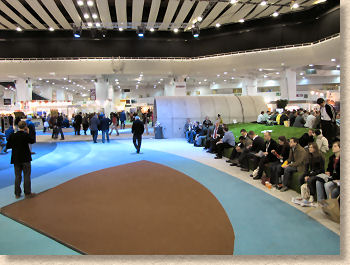
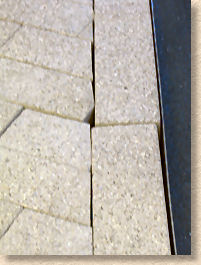
And why no proper documentation for those manufacturers/sponsors that weren't physically present? I understand the show's drive to be green and sustainable and not burden the environment with unnecessary waste, but surely some sort of "This is such-and-such and you can get from...." was warranted, wasn't it? If I'd provided free paving for this display, you can bet your bottom dollar that I would want everyone to know, and I'd require an explanation as to why they'd let Stevie Wonder do the cutting-in!
The other great attraction this year was the enormous number of 'seminars', held in a whole suite of "theatres" dotted around the two halls. The show notes claim there were over 100 different seminars over the three days, featuring an amazing range of speakers, several of whom could be thought of as reasonably well known. True to form out of the 100+ seminars available, the only one that really appealed to my tastes, "Floods'n'SuDS" was scheduled for Wednesday afternoon, the one day I was occupied elsewhere!

Every event worth its salt now has a program of seminars. It's all about 'adding value' for the white-collar sector of our industry, encouraging them to leave their nice warm offices on a cold winter's morning to attend an event such as this. Many shows feature seminars that are little more than 30 minutes of blatant product plugging but the schedule here was seriously top notch, cutting-edge, bang-on-the-money relevant discussions featuring leaders in their field, and this was evidenced by the packed theatres. Whenever I hobbled past any of the theatres, the crowd were spilling out of the doors and the benches were crammed to capacity.
The Exhibitors:
Hanson Formpave
With all the takeovers and upheaval that the erstwhile Formpave has been put through over the last two or three years, it would be understandable if they had been subsumed into the bigger brand that now owns them, but it's refreshing and reassuring to see them standing on their own feet, proudly independent from their masters in Hall 2, and still spear-heading the block paving industry in terms of innovation and sustainability.
A decade ago, long before the current fascination with permeable paving , Formpave were steadfastly pursuing what was seen as an interesting but minor sideline. Now, as the rest of the industry trumpets their own permeable products, Hanson Formpave leave them standing on their blocks (literally) by creating the first driveway-based bespoke geo-thermal heating/cooling system.
Aquaflow ThermaPave, as it's been dubbed, is yet another idea whose time is imminent. It's been used on the Hanson EcoHouse project at the Building Research Establishment (BRE) where it's working well, so now the Formpave team are eager to see it installed on other projects.
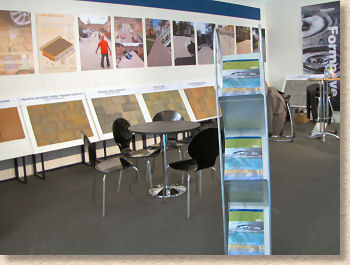
Another simple premise: use the thermal mass of a deeper-than-standard permeable sub-base to drive a heat transfer pump, providing sufficient warmth for underfloor heating in a modern 3-bedroom home during the winter, and cooling during the summer.
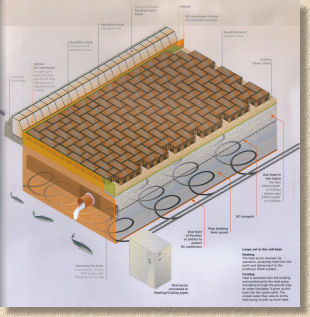
It's not a panacea, and Hanson Formpave is the first to admit that. It can't be retro-fitted to an existing property (or not without significant additional works), it costs more to install than conventional paving, and it needs the state-of-the-art insulation found in the newest homes to render it practical, but, as with those first permeable systems, it's a very significant step in a very important direction.
When your heating bill next lands on the doormat, think what it would mean to your pocket if the driveway was keeping you warm, and all for pennies a year!
Baggeridge Weinerberger
Another paving supplier now subsumed by one of our continental colleagues, Baggeridge had a stand in Hall 2, along with all the other corporate big boys, and although the bulk of their display focussed on the Weinerberger Baggeridge facing bricks, long-time clay paver aficionado and sales manager Mike Jepps had managed to get some of the Aquata® permeable clay pavers laid to the floor.
I struggle to understand why clay pavers don't fare better on this island of clay-covered coal in a sea of fish. The country makes some of the best and most beautiful pavers in the world, yet they are underused in the nation of their birth. Mike thinks it may have something to do with the very 'brickiness' of the pavers, the almost universal 2:1 plan ratio which doesn't offer the modern designer much in the way of versatility, but he's hoping Baggeridge will be doing something about that in the very near future.
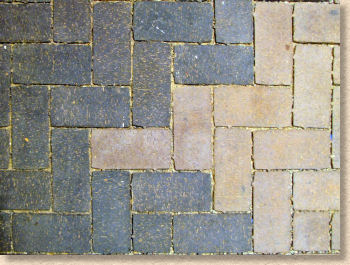
I hope they do. Some years ago, the Brick Development Agency ran an advertising campaign with the slogan "Brick makes Britain Beautiful". Well, clay pavers make pleasing pavements, as far as I'm concerned.
R2 Paving
Targeted more at the cutting-edge FutureBuild crowd, R2 Paving Solutions were showing off their impressive range of concrete paving products from HanseBeton in that Germany. These are highly innovative pavings, suitable for use in commercial, industrial and residential projects, with an enormous range of colours and finishes. Many of the flags are available with the unique HanseClean DoublePlus ® protective coating that renders the paving practically stainproof under everyday conditions - expect to read more about this special feature on the website in the near future.
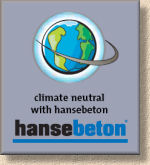
And to keep in line with the Eco-Enviro theme of the show, HanseBeton are claiming to be the first European manufacturer to offer customers "Climate Neutral" paving. In essence, the CO 2 emissions generated by manufacture and transportation are offset through the purchase of "emission reduction certificates" in association with ClimatePartner®, a company that specialises in that sort of green business.
Stein-Tec
Business must be good for Stein-Tec as David Burton had splashed out on an impressively large stand in a prime position to showcase the growing range of Stein-Tec bedding and jointing mortars, as well as the Weiss cleaning and sealing range. Slightly strange for a paving mortar specialist to besmirch the floor of their stand with timber decking, but then I suppose it would have been impractical to pave such a large area with stone.
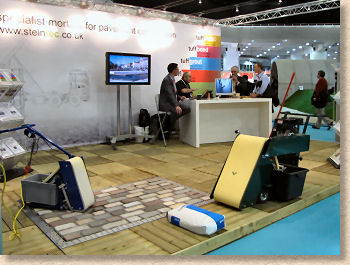
David has launched a new, fast-setting repair mortar, TuffsettG, which enables re-constructed pavements to be opened to traffic in as little as 3 hours, (Yes! 3 hours: that's not a typo) and like all the SteinTec products, it does this with no fancy chemical additives or polymers – just straightforward, infallible hydraulic setting of a quality cement and aggregate mixture.
CED
The market for quality stone paving is both busy and exceptionally competitive, so it was something of a surprise to see that CED had the place more-or-less to themselves as the only multi-stone distributor with a notable presence. It's annoying that the central plaza feature was completely devoid of stone paving, but CED more than compensated by displaying their eclectic range of stone from around the world in a tasteful yet effective floor display.
There's such a wide range of stone now available that it's impossible to pick out a favourite, but the porphyry is proving to be highly popular over the last few years, and it combines well with other igneous and metamorphic stones, such as the flame-textured granites that had been paired with it here.
As the theme of the show is all things enviro-eco-sustainable, sales director Ian Devenish was particularly pleased with the recycled ceramic sanitaryware, crushed to a multi-purpose 10mm size and presenting an aesthetically-pleasing buff, cream and white mixture with occasional slashes of white glaze. It doesn't look anything like you might expect crushed bogs to look like - it looks like a natural crushed gravel, but it's recycled, it's sustainable, and it's extremely hard-wearing, being more than capable of carrying vehicles on a driveway.
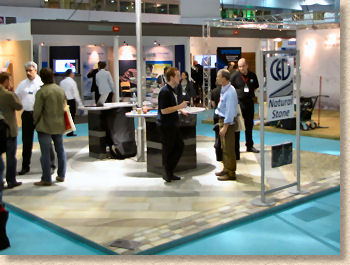
Forest Pennant
One of the genuine stone suppliers not banished to the Lilliputian Stone Zone, Forest Pennant somehow found themselves detached from every other hard-landscape exhibitor and mixed in with the online service providers, hemp-based building materials and eco-paints.
Sales director Simon Hart isn't likely to surprise us with new product. His family-run company produces supreme quality and highly distinctive Pennant sandstone from the Forest of Dean, and that stone is the same lip-smackingly gorgeous paving material that it was last year and last century.

While other companies may have started to supply Pennant stone from quarries in neighbouring counties, none can really match the distinctive colouring of genuine Forest Pennant, and as for the stone being brought in from China as a so-called "alternative"... Well, they say imitation is the sincerest form of flattery!
Great news, too, on a hydro-electric scheme at the cutting yard in which Simon has been instrumental - more on that in a week or so.
Johnsons Wellfield
Johnsons Wellfield are another example of a distributor with a single-stone type that is uniquely charming and crafted to perfection. The unmistakeable creamy hues of Crosland Hill Shot Sawn yorkstone is one of the classic paving materials of Britain, adorning city squares, town precincts and village centres from Yorkshire to London and beyond. Its simple, subtle colour and texture provide a surface that's both reassuring and reliable, stylish yet traditional.
It's good to hear that the Huddersfield quarry is working flat out to meet orders, and the demand for quality native stone shows no sign slowing up despite the economic woes affecting other parts of the trade.
The CNC machine is obviously working well, turning out fantastic bespoke pieces such as the corduroy 90° unit just visible in the photo opposite.
Stone such as this enables specifiers to offer a hardscape that will enhance both their design and the clients' amenity.
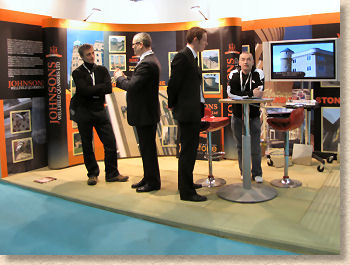
McMonagle Stone
Although their main stock-in-trade is natural stone, McMonagle Stone were using CityScape to showcase the Romex jointing mortars which they distribute throughout Britain and Ireland. For reasons that escape both me and sales director Michael McMonagle, they had been allocated a broom cupboard within the aforementioned grandly titled "Stone Zone" which in reality was couple of dozen square metres of booths and kiosks that unexplainably included non-stone products, while genuine stone distributors, such as those already meantioned, were located elsewhere in the hall.

It's not easy to demonstrate just how quick and simple are the Romex resin-based mortars in a closet, but sales manager Ray Graham was doing his best in very trying circumstances, and it seems to have paid off because Ray called me on Friday morning to boast about a seriously good lead they'd picked up at the very last minute.
SureSet
There have been some management changes at SureSet over the winter, but the heart of the company remains and the core product, top quality resin bound paving, is as good as ever.
SureSet had provided a stunning shimmering resin bound surface to the central showcase plaza based on a baby blue recycled glass, but their own stand focussed on the more traditional options of impeccably laid deep red granite and golden bauxite floor displays.
The large open stand was never less than busy and Lauren with her young team never less than attentive, despite the irritation of sample-snaffling gobby yoofs that seemed intent on testing the sales team's patience to the limit. The permeable surfacing demonstration model worked well, although it was small and easily overlooked positioned, as it was, against the main backdrop. Still, the demand for permeable options is bound to grow as the market develops, and SureSet are well positioned to make the most of the opportunities.
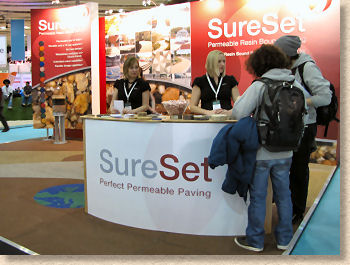
Addagrip
Rather than rely on the more usual floor-level display of their resin based surfacing, Addagrip hit upon the clever idea of bringing the surfacing closer to the innumerable visitors to their stand, by using it to cover the tops of their recycled 205 litre resin drums. No need to bend to get a better view or feel of the product, and an environmental angle too!
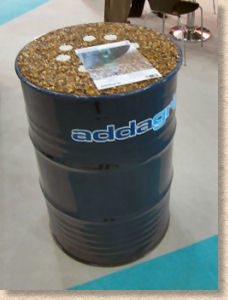
Further shrewdness in not just covering the drums with the various Addastone surfacing options, but covering them with contrasting design motifs to illustrate the design potential offered by resin bound surfacing.
Sales director Roger Critchley expressed his wholehearted delight with the event. Positioned at the main apex of the central showcase plaza, the triangular stand was impossible to miss and could hardly have been in a better spot. He was particularly pleased with the level of interest shown the new resin flooring system, Addagrip EDL, which brings to mind those LSD-inspired liquid projectors beloved of 60's student parties, although I'm showing my age in admitting that!
Easylay™
Easylay® are a new name in resin bound paving, and one that has a lot to learn. The basic product is based on a permeable mix of recycled tyres and aggregates, which is all well and good, but I was initially confused by the modular 'tile' format. Why would anyone want to lay it as 450x450mm tiles? Apparently, it's also available as a poured product, which makes far more sense, but this wasn't immediately obvious from this display and as a poured product, it's not exactly revolutionary or ground-breaking.
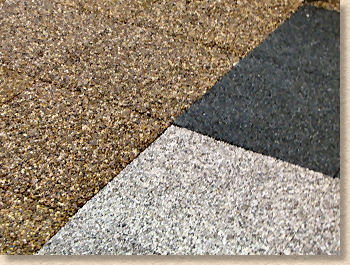
I took away the literature after the first day and was underwhelmed by the inaccurate description of last year's comedy driveway legislation and the complete lack of build-up information. So, on my return, I asked one of the sales team about the sub-layers which almost sent the poor soul into a state of apoplexy. The first suggestion was to lay the tiles directly onto 'hardcore', but when it was explained that it's impossible to regulate a sub-base accurately enough to accommodate a tile, the next suggestion was to level things up using sand.
Thanks, but no thanks.
City Roofs
Twelve months ago, City Roofs was a nebulous start-up, another new face in the burgeoning green-roof industry, but with the advantages of having CRH-Zoontjens behind them and the well-experienced Matt Hoddinott as the public face. While several of the other "New Faces of 2008" have fallen by the wayside, City Roofs have stuck to the road and Matt says he's delighted with everything they've achieved in such a relatively short period.
The business model remains the same: if it's needed to create a roofscape, City Roofs will supply it, whether it's vertical greenery, podium decks or roof parking systems. The company acts as a sort of filter, removing the dross and the also-rans and providing architects with a range of what they call "A Brands", the good stuff, the cream, and remove the need for busy designers to juggle half-a-dozen different suppliers.

Naturally, the product range has matured and certain lines have attracted a great deal of attention, most notably the green walls, which were literally being pawed to a state of advanced alopaecia at this show. For me, though, the extra-heavy-duty deck slabs for car parking were of most interest. Simple designs, gently coloured and incredibly versatile, these represent the surfacing of tomorrow for urban buildings.
Aco
There was no shortage of drainage manufacturers at this event, but the vast majority of them were offering simple variations on a theme, tweaks and form changes to well established existing products: storm cells with in-built filtration membranes; interesting geometric reconfigurations; minor improvements in connectivity or void space. Aco seem to have stuck to what Aco do best, which is linear drainage kerbs and channels for all sorts of applications.
All their products are subject to constant technological and manufacturing improvements, and there are the only-to-be-expected regular upgrades and minor changes, but you don't lightly mess with a winning formula, so any radical changes need to be warranted and viable.
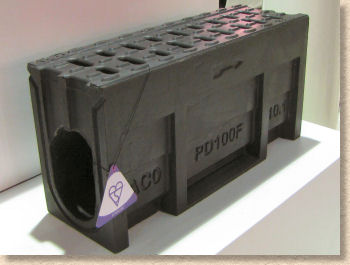
And so it is with the new Vienite® polymer concrete which is now being used to manufacture the Kerb-Drain range. They're understandably cagey about just what this Vienite® stuff might be, other than to confirm that it's a polymeric-based recycled material that is highly durable and recyclable at end-of-life.
Oh: and it is patent pending!
Aco KerbDrain® has achieved "Kite-marked" status, an incredibly valuable acknowledgement following last years 'fuss' over combined kerb-drain units.
Pipeline and Drainage Systems
Probably best known for their EnviroKerb range, Pipeline & Drainage Systems have recently launched "EnviroChannel", the first single-casting linear channel. The PDS people realised that traditional channel + grating systems were failing because the grating was not being properly locked back in place following basic maintenance, or was being robbed by the local scallies for a scrap iron weigh-in bonus. If only there was some way to make the grating and channel all one and the same....
And so EnviroChannel came into being. Extruded as single entity, complete with drainage slots, the EnviroChannel is manufactured using the same reliable recycled polymer composite as the EnviroKerb, with a D400KN load classification and available with level or stepped inverts to suit individual projects.
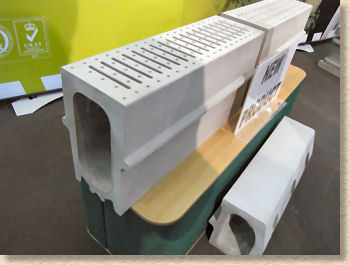
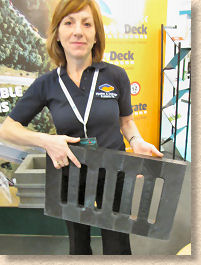
And plastic composite technology doesn't end with kerbs and channels. The PDS team have used their experience to develop a strong-but-lightweight emergency gully grating that can be dropped in place as a temporary replacement for gratings that have broken or mysteriously vanished along with numerous street signs, railings and other metalliferous wares. Weighing a paltry 12kg yet capable of taking the weight of a fully-laden HGV, these gratings are ideal for highways maintenance teams and won't weigh down the van!
TDP
I had been wondering what had happened to Netlon. It hadn't been keeping me awake at night or anything as extreme as that, but I'd noticed a number of emailers and callers were asking where they'd gone and who was supplying the NetPave products. I had to admit I didn't know.
But now I do, thanks to a chance encounter at EcoBuild. I spotted TDP , distributors of a range of landscape and construction geo-textiles, trapped on a stand between Halls 1 and 2, and was casually flicking through a product overview brochure when I spotted the Netlon products.

They've promised to update the info I have on the website, so with a bit of luck and a following wind, the great disappearing Netlon mystery will itself disappear!
Summing Up
While attendance was generally good, it has to be admitted that a significant proportion of those were students. College students have to be considered a necessary evil: they scurry around like a pack of rats picking off as many freebies as possible, but we have to tolerate them because some will actually pupate and emerge from their chrysalis as the architects, designers and specifiers of tomorrow. However, the swarms of schoolchildren are another matter.
They were behaving exactly as can only be expected of teenage schoolchildren – pretty badly. They were like a plague of locusts descending on any complimentary sweeties or nibbles; they were amusing themselves by asking double-entendre laden questions; they were brashly interrupting genuine business discussions; they were bloody rude. Not all of them obviously, but enough of them to qualify as a damned nuisance.
I'm all in favour of allowing what we used to think of as the fifth year (Year 11?) attend such an event to let them experience a taste of our industry, but they need supervision. I don't want to be barged out of the way by some hormone-riddled youth hell-bent on grabbing a handful of jelly babies, and I certainly don't want to have to endure a tableau of tonsil hockey and mutual groping while waiting for my cup of tea.
The main grumbles amongst exhibitors and visitors concerned the baffling layout in Hall 1, the hall that hosted CityScape. While the central 'plaza' was unmissable, arranging all the displays along diagonals, and then labelling them with a non-sequential throw-a-six-to-start numbering system was a bizarre decision. It was a nightmare to recall who was where and in what direction to travel to get to the next point of interest.
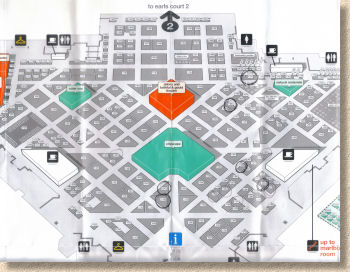
For the hard-landscaping fraternity, this was then compounded by applying the scattergun planning system to the allocation of stands. Unlike last year when all the interesting folk were dotted around the central plaza, this year saw them cast to the four winds. Some were lucky enough to be there or thereabouts, but then the ridiculously small “Stone Zone” assemblage of broom cupboards was some way off (4 aisles NW then 3 rows NE) and others, such as Forest Pennant Stone, were totally disconnected. While stand space and pricing obviously affect an exhibitor's location, there seemed to be neither rhyme nor reason to this layout.
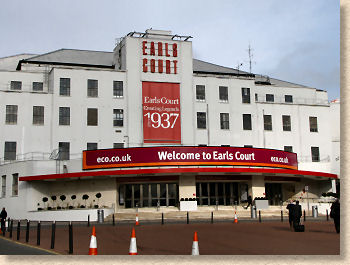
Other than that, the general perception by the time I left on Thursday afternoon was that it had been a success. There were one or two unhappy souls, disappointed that they hadn't received the visitor numbers of quality leads they hoped for, but most were happy enough and considered it to have been a worthwhile expenditure of time and money.
As with any event such as this, the real proof comes over the next few weeks and months as leads are followed-up and vague promises converted into firm orders.
Maybe the show wasn't as fizzing as last year's event, and maybe that has something to do with the economy, but CityScape retains its crown as the most important show for the hard-landscaping trade. Perhaps StreetDesign at the NEC next month can give it a run for its money, but given the track record of its previous incarnation, when it was known as External Works, that seems unlikely.
There's room for improvement, and it really needs more commitment from some of the BIG names in hard-landscaping, but for now, it's the best we have.


